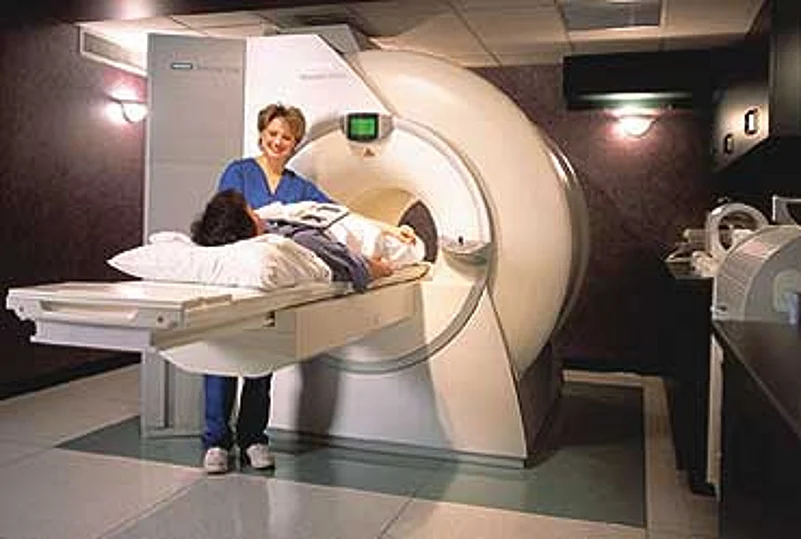When the science catches up with the fiction, does science fiction (SF)transmute somehow into 'normal' fiction, whatever that might be? Take forexample, a theme like sex in space. This has been explored ad infinitum insub-genres ranging from swash-and-buckle space opera to social allegories andmagical fantasy. Everything from the pros and cons of floating upside-downweightless while performing coitus, to the effects of low gravity on the humanreproductive system has been discussed in (occasionally disgusting) detail.
The theme is still SF- but the expiry date is pretty close. By 2020, spacewill be just another exotic location for rich honeymooners. There are persistenturban legends about a grand total of three space-sex encounters that havesupposedly occurred in nearly 50 years of extra-terrestrial exploration. Butspace missions have usually been manned by same-sex crews operating undermilitary discipline in spartan conditions with zero privacy. So it’s notsurprising if the act has occurred very infrequently (if at all).
Circa 2008, Virgin Galactica will launch its orbital flight service. Morethan 3,500 tourists have already booked tickets at $200,000 a pop with a$20,000advance payment. Each 3-hour flight will reach 100 kms above the Earth’ssurface and incorporate around five weightless minutes. Passengers will travellying on comfortable acceleration couches in pressurised cabins with allmod-cons.
Five minutes is time enough for a quickie and surely somebody will be hornyenough to contemplate screwing for science (or tabloid stardom, as the case maybe) under these circumstances? If hanky-panky doesn’t occur on a Virginorbital flight however, it will surely happen once the rich and famous emulateDennis Tito and start spending quality time vacationing on space stations.
One way or another, the membership roster of the "hundred-mile-club" issure to swell dramatically in the near future. Does this imply that extant SFfeaturing space-sex will move into a more mundane category once Silhouettestarts setting romances in space?
If we insisted on such a reclassification, much of the SF opus would shiftcategory. The science in SF and in associated genres like fantasy is oftenhit-or-miss. Ultimately the fiction is more important to the writers than thescience. But every major advance in technology over the last 200 hundred yearshas featured in fiction before it became fact and a lot that’s now cuttingedge now was written about decades ago.
Some SF writers belong to the hard school of "scientific romance," thatwas mid-wifed by Verne and Wells in the 19th century. The hard SF writerssuch as Arthur C Clarke, Alfred Hoyle, Isaac Asimov, Larry Niven, RobertHeinlein, Poul Anderson, Jerry Pournelle, Ventnor Vinge, Nancy Kress, David Brin,etc, have usually centred their stories on intelligent extrapolation of scienceand technology. Most have training in the sciences, and quite naturally, thisschool of writers has the highest strike rate in terms of accurate predictions.
To this school, we owe accurate descriptions of transportation such asrockets and submarines. In fact, between Verne and Wells, most of modern sciencewas tied up and delivered in the guise of fiction.

Verne’s From the Earth to the Moon was published in 1867, more than acentury before Neil Armstrong made it to Mare Tranquilis. Verne also receiveddue recognition for his guesses about underwater travel in 1954. That’s whenthe US Navy launched the first nuclear submarine "Nautilus," named in honourof the brooding Captain Nemo’s vessel which made its literary debut in 1875.
After Verne, there was Wells. In 1898, in the War of the Worlds, Wellsdescribed the use of an alien "heat ray", which is very close to a modernlaser or maser. Wells also predicted gene-splicing in The Island of Dr Moreau,where animal and human genes are mixed together to create monsters.
Wells coined the term "atomic bomb" in the The World Set free,(1914), though his device postulated a continuous chain reaction where each bombkept exploding for days on end! Furthermore, Wells hit on the idea of biologicalwarfare when his Martians died from an assault by terrestrial microbes.

In later years, Arthur C. Clarke conceptualised the geostationarycommunication satellite in a 1945 essay about using the "V2 for IonosphericResearch". Robert Heinlein dreamt up the cellphone (he called it the"pocketphone") in Space Cadet (1948), where he also thought upmicrowave ovens. Yes, Heinlein also contributed the idea of "waldoes" in Waldo. These are remote handling devices used in the telefactoring industry forwork in hazardous environments. And, of course, Heinlein contributed "grok"to geekspeak in Stranger in a Strange Land while describing a bizarre sense ofcommunion that develops between cannibals, who conduct group-orgies.
Asimov wrote many entertaining stories about robots and androids though weowe the origin of the word to Kafka’s brother-in-law Karel Kapek.. Asimov didalso script Fantastic Voyage which was a very early take on nano-technology.
The surprising thing however is that accurate predictions have so often comeout of sub-genres other than hard SF. Perhaps the weirdest prediction occurs ina scene from one of Edgar Rice Burrough’s Martian fantasies (circa 1920) wherea normal homo sapiens somehow impregnates an egg-laying woman while traveling ina magnetic elevator. Mag-levs and monorails are now part of modern transporttechnology though nobody has really discussed oviparous-viviparous reproductionsince John Carter of Virginia had it off with Dejah Thoris of Barsoom.
An entire range of social allegorists ranging from Aldous Huxley, E.M.Forster, Kafka and Orwell to Philip K. Dick, Doris Lessing, Ursula Le Guin, KurtVonnegut, Margaret Atwood and Iain Banks have used science as a sort of literaryMcGuffin - as an Hitchcockian instrument that conveniently moves the actionalong. Sometimes their predictions have been awesomely prescient even if theyweren’t particularly concerned with the science.

E.M. Forster, for example, wrote the novella, The Machine Stops in1909. That seminal story features television, medical telemetering systems aswell as what is recognisably a prototype MRI machine. Forster doesn’t rankvery high in the canons of either scientific thought or SF - yet he did dream upthree very interesting bits of technology.
The Internet and its surveillance possibilities featured in 1984. Or atleast, the all-pervasive surveillance system of Big Brother that depends on TVsthat transmit images of every locale can certainly be reproduced by modern Nettechnology and its movement-sensing webcams. In a small way, Big Brother’stechnology is prevalent in airports, malls and other public places though it’sused more often in the home for cybersex than for standard surveillance.
Of course, many other writers "saw" other bits and pieces of the Net. Aslong ago as 1909, Hugo Gernsback wrote about machine translators in Ralph124c-41. In his Hitchhiker’s Guide series, Adams invented the Babelfish, an alienanimal which can be swallowed to provide universal implanted translators. In1958, James Blish thought up the "message tree", which maintains a globalcommunication standard across a planet, in much the same way that the Net’sICAAN servers do.
In The three Stigmata of Palmer Eldritch (1964) Philip K. Dick’scharacters received personally customisable news from e-zines and spendbiometrically-keyed currency ("truffle-skins") that cannot be stolen orfaked.And, of course, William Gibson coined the terms "cyberspace" and "virtualreality" in Neuromancer, where he also talked about hacking and anti-hackingmeasures a decade before these became prevalent. John Brunner in ShockwaveRider (1975) imagined a "computer tapeworm" that destroys networks.
In Idoru, Gibson also thought up a virtual pop-star, an idea whicheventually influenced the creation of the virtual news-caster Ananova. NealStephenson wrote about the legal implications of off-shoring data before anyoneelse thought of the concept. And one must credit Blish for dreaming up cyborgsin his early Star Trek scripts. Not that smart implants are terribly popular asyet but experiments have been done.
Coming back to biology, Niven wrote the chapter and verse on organtransplants in the 1960s in his Known Space novels, at a time whentransplants had just entered the realms of the possible. Niven conceptualised"organ-legging" or the illicit trade in organs, 25 years before peoplestarted waking up in Chennai hospitals with missing kidneys. He also postulatedsmart prosthetics, which haven’t really happened yet.
The first person to extrapolate cloning in detail was Huxley in Brave NewWorld (1931), a social allegory, which builds an entire society aroundcaste-conscious clones. David Brin did an equally interesting take on this morerecently, in Glory Season, where he explores the probable tensions betweenclones and "normals" in a futuristic environment where normals must fightfor the right to be allowed to establish new clone bloodlines. In between Huxleyand Brin, multiple clones of Duncan Idaho featured as faithful servants of theAtreides clan at various points of the Dune saga.
Where will we go from here in terms of SF predictions coming true? One niceplace would be functional immortality. This could happen in several ways - oneroad is of course, cloning, which guarantees physical immortality withoutensuring transfer of personality or memories. We are very close to human cloningin terms of technological competence- there are even some unverified claims thata loony sect called the Raelians have already conducted successful experimentsin human cloning.
Another route to immortality could arise through cyborg brain implantsallowing a continuous real time data download of experience. This idea isexplored in some detail in Iain Bank’s Culture novels. Here, a devicelinked to the brain can store all the memories and experiences remotely as theyare undergone in real-time and that data can then be played back into anotherbrain. It would then be "grokked" as though it was personal experience.
Combine this technology with reliable cloning and you may actually haveimmortality. To store the amount of data a human CPU generates in a sufficientlyfine-grained fashion would require prohibitive RAM and CPU resources but maybeMoore’s Law will stay valid for long enough for this to happen.
Also quite ambitious is the possibility of freezing critically-ill peoplesuffering from incurable complaints through the use of cryogenics to give them achance of revival once cures are discovered. The hibernation concept has poppedup too often in space opera (including the Alien series) for one to creditit to a single person. There are already cryogenic banks, which undertake topreserve the corpses of their customers for long periods in the hopes that theycan eventually be revived through some scientific miracle.
Of course, genetic advances will lead to some diseases being betterunderstood and hopefully, wiped out within the next few decades. Aids and Cancerwould be primary targets of this approach.
Genetic engineering could also be used to improve the physical abilities ofthe human race and perhaps, even to control or change basic patterns such as theneed to sleep or menstruate. Nancy Kress’ Beggars in Spain explores thisidea - what would happen if otherwise normal people spliced out the need tosleep and thus became twice as productive as their peers?
Teleportation (instantaneous movement of live people), faster-than-lighthyperdrives, the nano-fax (which faxes identical copies of 3-D artifacts),instant communication devices and riding around on broomsticks playing quidditchare unfortunately more distant possibilities. The first four seem to violatebasic laws of physics although there could be some possibilities of exploitingblack holes to get around this.
Of course whenever one runs into an impossibility, optimists cite Clarke’ssecond Law: If a distinguished and elderly scientist says something isimpossible, he is wrong. But playing quidditch would require the development oftechnology that conforms to Clarke’s Third Law: Any sufficiently advancedtechnology is indistinguishable from magic. Maybe it’ll happen though.
A slightly shorter version of this appears in print.






















